Greek Music in the Mystery
There was good music, and there was bad music, and a certain type of music was vital to the rite
“The beginning of all harmonic theory is judgment by hearing.”
(Aristoxenus, Harmonics I.1)
- Intro
- Dithyrambic Audio Examples
- Four winds
- Lyre
- Kithara
- How many strings?
- System
- Oiling Strings
- Bending Strings
- Bending described in the Ancient Sources
- Tuning
- Initiation
- Temple Acoustics
- Amphitheater Acoustics
- Theory - Scales, Tetrachords, and Tonoi
- Vocabulary
- Sources
- Relevant LadyBabylon episodes
Intro
Music was an integral component of the mystery rite to form the right mental space for the initiate.
Dithyrambic Audio Examples
Four winds
Macrobius Macrobius, Saturnalia, 1, 19, 26
Lyre
Learn about the sonic physics of the lyre, how it could have been played.
[link]
Traditionally constructed with a round tortoiseshell sound body, with stretched hide drum over it, and horns (or sticks) and crossbar and tailpiece to hold the strings, over a bridge resting against the drum.
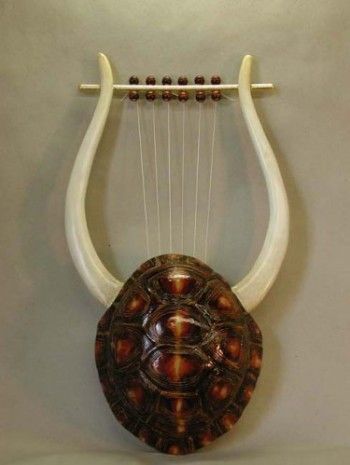 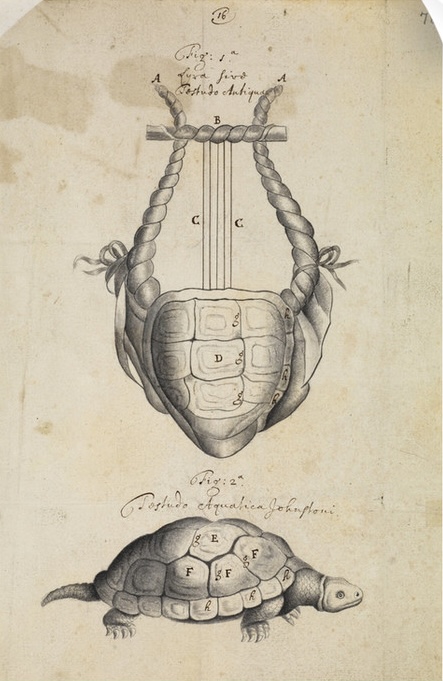 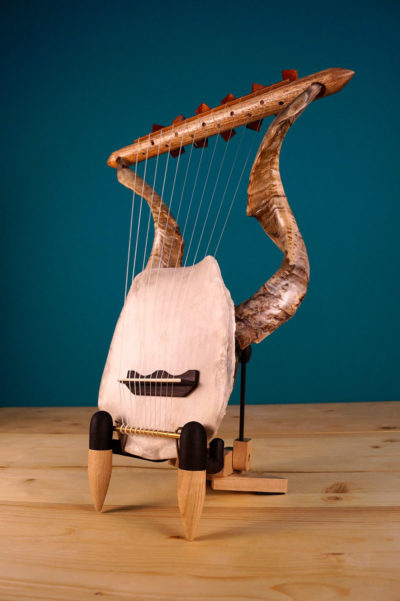 |
Kithara
The kithara is the same as a lyre but has a more integrated wooden box instead of the "tortoiseshell with sticks". Used more by professionals.
[link]
How many strings?
the 7-string lyre/kithara is ideal since it will cover two tetrachords. Two series of four notes in a row. The central tetrachord to all greek music is the descending scale a-g-f-e, join that with descending from above d-c-b-a and a becomes the synapse joining them and thus becomes the "middle string" representing helios
The 12-string kithara just affords a couple more notes. That way the player doesn't have to bend(-restretch, retune) the strings when switching from something like Athenaeus's Phrygian mode to Nicomacheus' Ionian.
System
Here's the basics of their greater perfect system on the right with the lesser perfect with the notes on the left
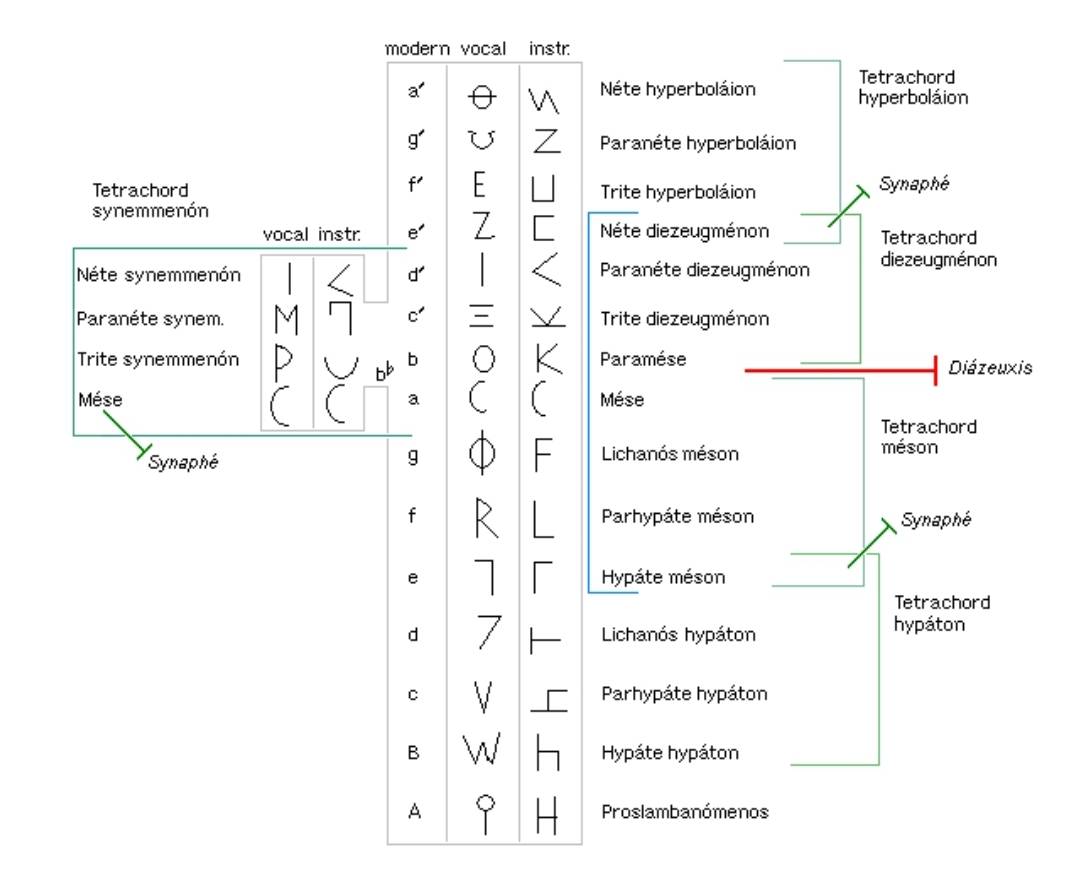
Oiling Strings
Christing the strings is vital. Just like any ritual tool should be washed and fumigated according to their nature, so should the kithara.
- some may choose silk+steel strings (modern)
- some may choose sheep gut strings (traditional)
it's a three-fold application.
- In the physical/material realm, the oils do serve the purpose of 'lubticating' the strings so that a plectrum can glide smoothly across the strings without getting "caught."
- Then on the mental realm, the ritual act of oiling the strings "ties" us back to ancient roots.
- And then on the Empryan level, with the various oils, we are evoking the element of the waters.
- EARTH: The wood and strings are of course, of earth.
- AIR: The sound we produce is aerial,
- FIRE: the act of the plectrum hitting the strings cause friction, like small pockets of fire, and lastly
- WATER: the oil on the strings keeps these fires burning at an appropriate level.
- Thus we achieve the balance of the four elements: Earth, Air, Fire, and the Waters
Suggestion: reading a bit of Hekate Soteira by Sarah Iles Johnston as well as Ruth Majercjik's trans of the Chaldean Oracles(originally by Julian the theurgist). Those two texts help to understand what's going on with the three realms. It's physical and spiritual, with the mental in between the two acting like a bridge/mirror/membrane.
You only need three pharmakons: frankincense, myrrh, and storax
Here's the Ionian mapping from "top" to bottom string
| Greek Letter | Deity | Substance | Modern Note |
|---|---|---|---|
| A | Kronos/Saturn | storax oil, tuned to the pitch(tonos) | D |
| E | Jupiter | frankincense, tuned to the tonos | C |
| H | Mars | storax, tuned to the tonos | B♭ |
| I | Helios | Frankincense, tuned to tonos | A |
| O | Aphrodite | Myrrh, tuned to tonos | G |
| Υ | Hermes | storax tuned to | F |
| Ω | Selene | myrrh tuned to | E |
Bending Strings
"bending" notes on kithara.
- All you need to do is apply pressure on the (dead) strings between the bridge and tail.
There's other options too
- push on the (dead) strings between the bridge and tail
- push down with hard finger nail, up by the tuning pegs, leaving your other hand free to play the string
- on the tuning peg side side you can bend a tone and a half easily with little effort, and it's real sensitive and responsive to touch. It dampens the volume and sustain of the string a little bit, but not too much. If you do it enough from the tuning pegs it kind of gets at a lower or higher pitch if you do it consistently
- use your hard finger nail to pull a string horizontally (sideways) in the middle
- wherever you place your nail will create a new tuning (pretty disruptive / or advanced)
- pulling will bend the note (increase tension)
- use the other hand to play the string
#1 Pressing behind the bridge is the least technicality required.
All three options [1,2,3] could be required depending on the technicality of the logistics to achieve intended purpose...
Bending described in the Ancient Sources
Ancient sources definitely describe pitch-bending and string manipulation
Aristoxenus (Harmonics) stresses that intervals are by ear and that singers/players execute fine distinctions smaller than a semitone, especially in chromatic/enharmonic genera. This implies micro-bending or adjusting pitch.
Pindar (Pyth. 12.20-25) and later scholia on lyre technique mention pêxis (pressing strings) and syrigmos (sliding tones).
Aristides Quintilianus (De Musica, 1.9-12) says that enharmonic dieses are narrower than the semitone and can be produced on the lyre by subtle tuning and finger pressure.
Pollux (Onomasticon 4.66) lists terms for “pressing down” the string near the peg to raise pitch
So our ancestors did allow for non-fixed pitches. On the kithara, pressing a string between the nut and peg shortens it and raises pitch precisely the technique needed to realize hypesis/diesis (acute/grave/circumflex) inflections that don’t correspond to a base string.
Accents are expressed by bending the string to which that particular vowel is assigned, and not by playing a different chord(string) in the chosen harmonia/heptachord or "scale"
Tuning
I can definitely tell when I have the strings tuned d c b a g f e it feels like the kithara is perfectly in tune it just feels natural
Initiation
Initiations were done in a variety of locations from Amphitheaters to smaller Temples to rooms.
All that is required is some land about the size of a threshing floor and a skene tent
The actual initiation in itself takes place over three days, you gotta be starved first
Fumigations:
- Larger: That whole stadium got really cloudy pretty quick with like 40 thuribles going on all at once.
- Smaller: Tents were built with cloth walls, with the person of interest directly in the path of the fumigation.
Temple Acoustics
Threshing floors created an obvious space for temples or ritual spaces the rest of the year outside of harvest.
- Round spaces and stonework created great acoustics for instruments.
Tents or cloth walls created a closed space when needed, for fumigation (temple incense frankincense, mhyrr, cannabis, opium, etc), which helped create the right mental state.
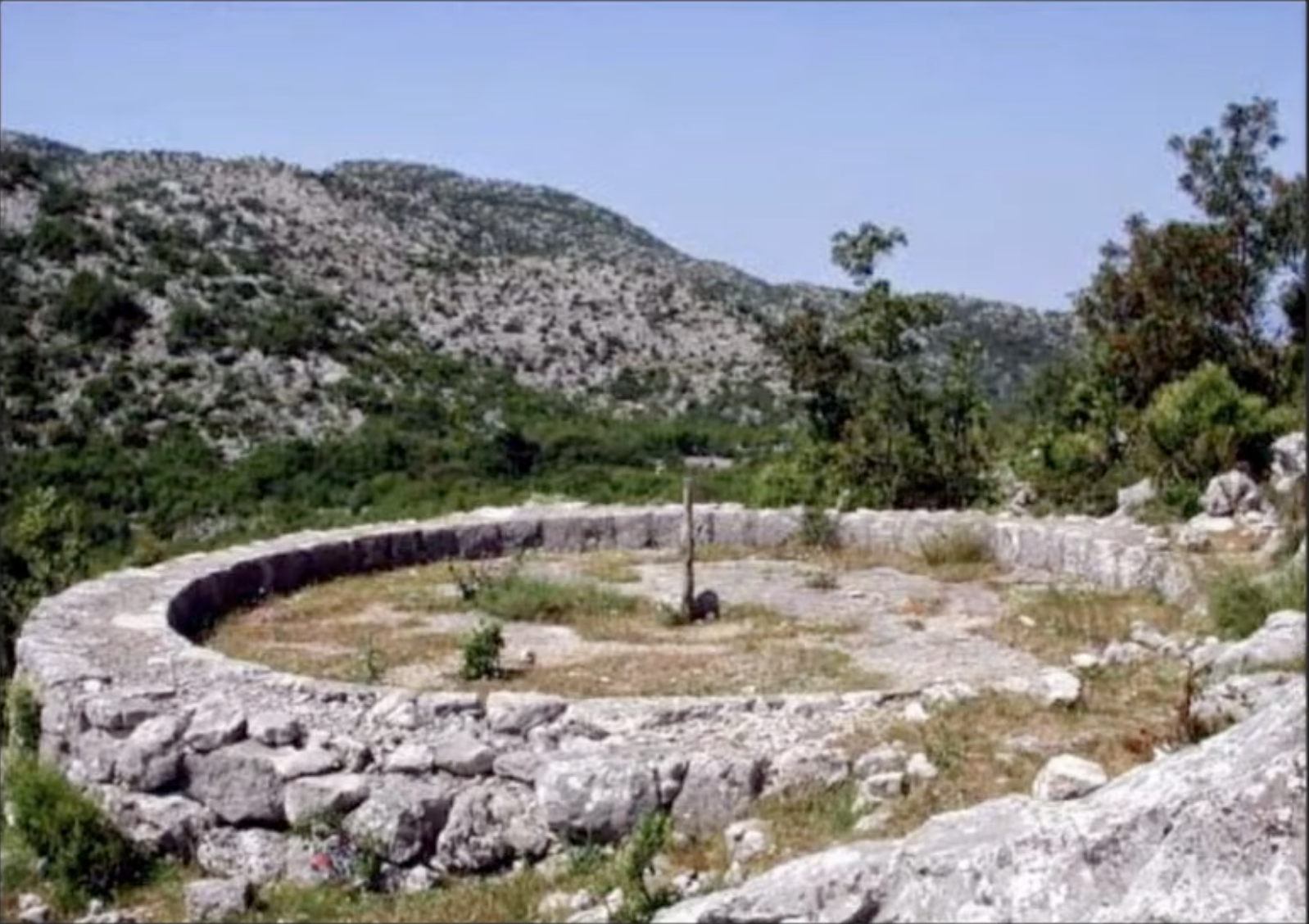
Threshing Floor
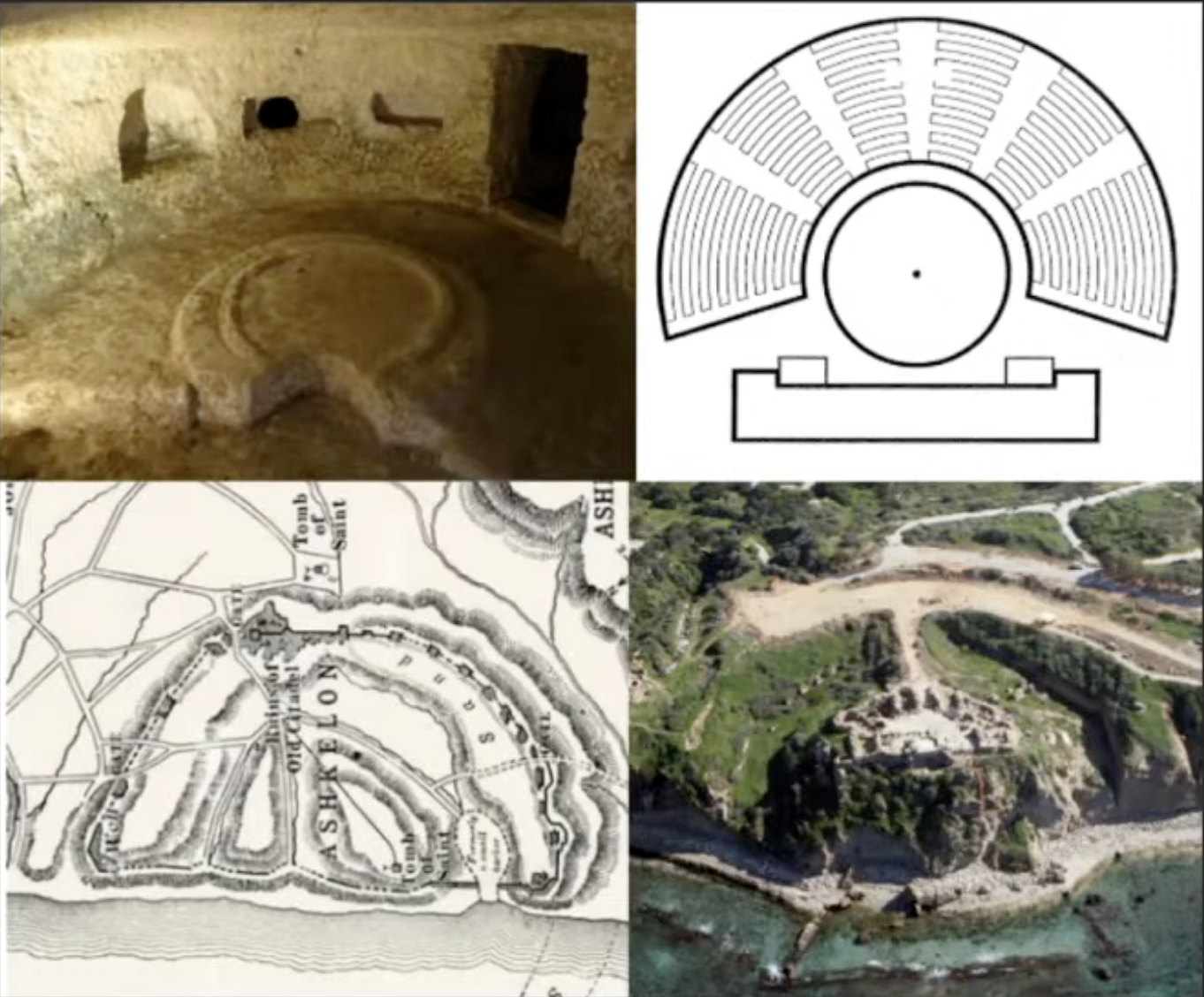
Amphitheater Acoustics
their acoustics were top notch, the shape of the theatre is Ω because it perfectly amplifies the sound so that people standing way back can hear clearly
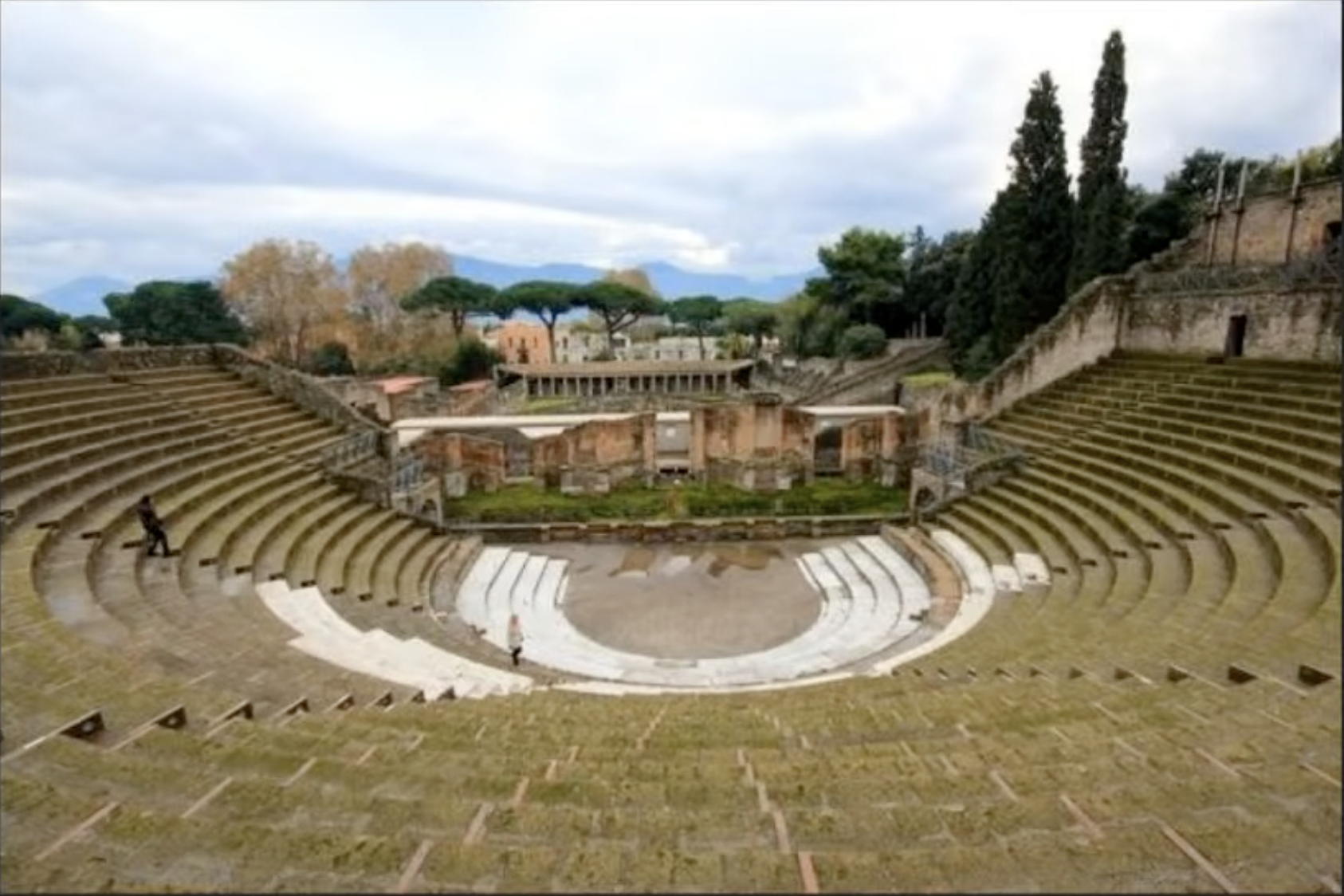
Omega Shaped (Horseshoe) from the hellenized period.
Threshing floor is already a centralized spot for rituals.
Used as amphitheater the rest of the year.
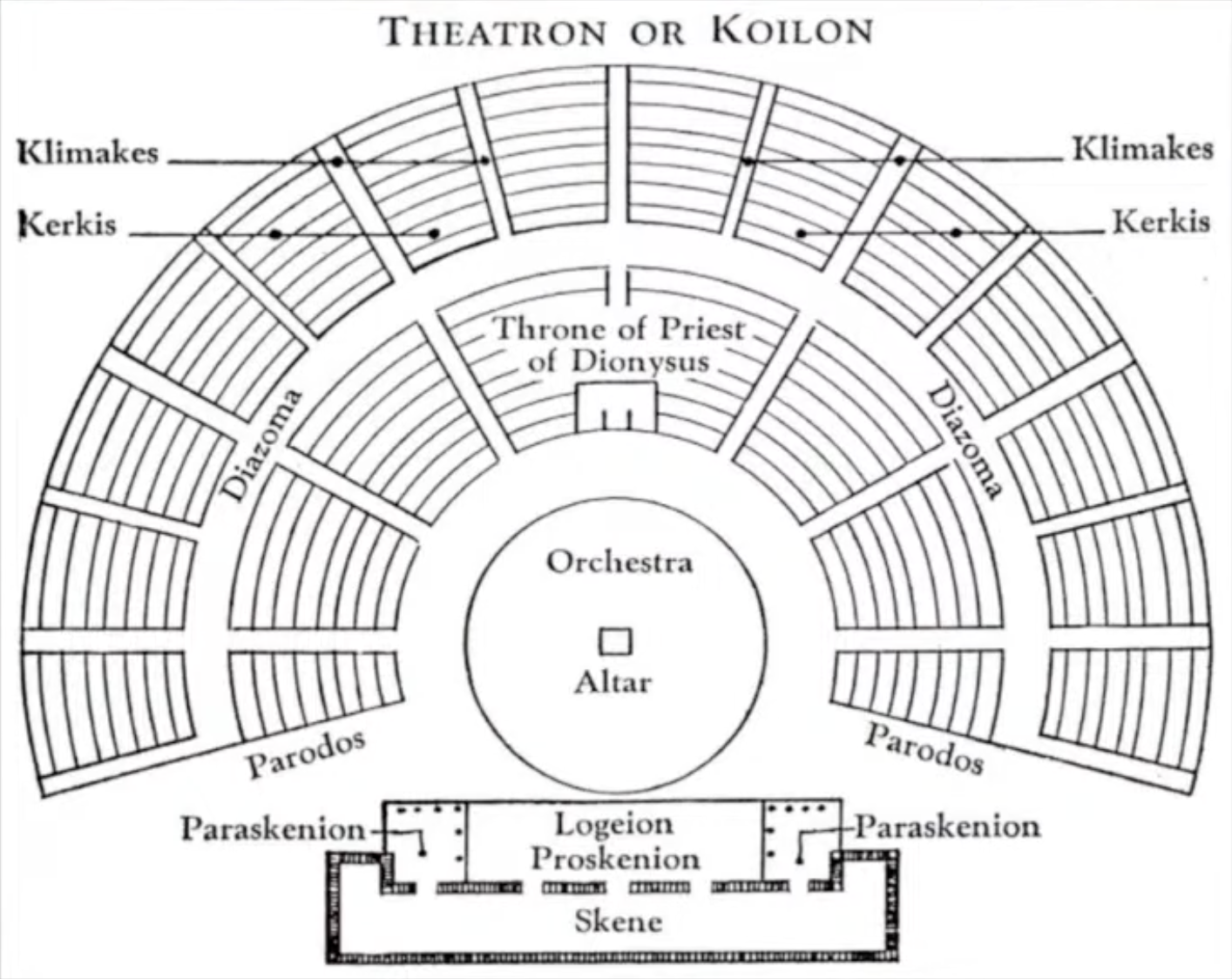
Dionysus festivals
Rituals dont go away, becomes theater, best poet wins a goat.
3 kinds of plays, tragedy (life, love, death, loss), comedy, satry play,
Tragedy grows out of dithyramb.
Skene is where they change, show different scenes.
Also, this omega shape is a schematic for vagina/skenes glands.
Theory - Scales, Tetrachords, and Tonoi
Ancient Greek music theory was not a single unified system but rather a collection of competing approaches. Aristoxenus, a 4th-century BCE theorist, is remembered for mediating between conflicting schools and systematizing them into a more coherent framework.
Tetrachords and the Heptatonic Scale
There were conflicting and competing music theories, but thankfully Aristoxenus was the great mediator and made the competing theories harmonious, as for the astrotheology, we're all set with Orpheus to tune us in.
At the heart of Greek music was the tetrachord (τετράχορδον), a sequence of four notes spanning a perfect fourth. By joining two tetrachords, the Greeks built their heptatonic scales.
One example scale is:
- First tetrachord (descending): A – G – F – E
- Second tetrachord (descending): D – C – B♭ – A
The note "A" in this case will be the synapse, or connecting note to the next tetrachord
When combined, these form the heptatonic scale:
D – C – B♭ – A – G – F – E
This structure could then repeat in cycles, descending like a fractal spiral, just like our ordering of the cosmos.
Tonoi (Scales) and Modes
Greek theory described tonoi/τόνοι (scales), which included diatonic, chromatic, and enharmonic forms.
- The diatonic system, close to modern scales, eventually became the favored framework.
- The chromatic system included semitones and minor thirds.
- The enharmonic system made use of microtones such as quarter tones, which are very different from modern Western practice.
And each mode is designed for different ritual settings: "mourning, paeans, dithyrambs, processions", all lend themselves to different modes of harmony
Music begins one note at a time, that central note for our purposes is the modern pitch A, but there is a universal way to symbolize that by the vowel iota but also as the planetary sigil of the sun. But, everybody has a unique tuning to them according to their individual nature and birth chart. But the ionian d-c-bflat-a g f e is the somewhat standard from which we approach things.
The Role of the Mese
Each scale had a mese (μέση), or “middle note,” which functioned much like the tonic in modern music.
For example, in an Ionian scale (descending order):
- D – nete Kronos - alpha α
- C – para-nete Zeus - epsilon ε
- B♭ – trite Ares - eta η
- A – mese Helios - iota ι
- G – lichanos Aphrodite - omicron ο
- F – para-hypate Hermes - upsilon υ
- E – hypate Selene - omega ω
(*** it is a diatonic heptachord, built from two tetrachords, Linked together at A (the mese))
Deities:
- Each scale degree was associated with a deity, showing the astrotheological dimension of Greek music, where tones and strings reflected cosmic order.
Diesis/Hypesis (♯/♭ Sharp/Flat)
Raises or lowers by a semitone (or quarter tone if using enharmonic)
- ὶ - Hypesis (♭) - lower the pitch by a semitone/quartertone (A → A♭)
- behaves like a modern ♭
- acute: looks like a downwards diagonal line (like an acute accent - ὶ)
- Example: So a base mapping of (eta η) Η → B♭, when acute-marked, would typically be sung higher as B natural / raised relative to the surrounding notes.
- ί - Diesis (♯) - raise the pitch by a semitone/quartertone (A → A♯)
- behaves like a modern ♯, often lower/falling
- grave: looks like an upwards diagonal line (like a grave accent - ί)
- Example: So a base mapping of (eta η) Η → B♭, when grave-marked, would typically be sung lower as A natural / lowered relative to the surrounding notes.
- ῖ - Díesis then Hýpesis (ί ♯ then ὶ ♭) within one syllable - raise then lower the pitch by a semitone/quartertone (A → A♯ → A)
- behaves like a small melisma, rise then fall, within the same long vowel or diphthong
- circumflex: looks like ˆ or ῀ (like a circumflex - ῖ)
- Example: So a base mapping of (eta η) Η → B♭, when circumflex-marked, would typically be sung bending up then back down, as B♭ then B then B♭ relative to the surrounding notes.
For example, if there was a Hypesis (like a grave accent) over the iota (ὶ), it would lower the A by a semitone to Ab and we would get modern Ab Phrygian
- If A → Ab, the whole structure shifts:
- D–C–Bb–Ab–G–F–E
- lowering the mese (A → Ab) by a semitone transforms the mode into what maps onto modern Ab Phrygian
- A mora is a unit of syllabic length or timing in Greek prosody and music.
- Short vowels count as 1 mora, long vowels or diphthongs count as 2 moras.
- In singing, accents like the acute target the principal mora of the syllable — for example, in a long vowel, the pitch rise occurs on the first mora of that vowel.
Melisma
- A melisma is a sequence of multiple pitches sung on a single syllable or vowel.
- The circumflex accent in Greek often produces a micro-melisma: the pitch rises and then falls within a single long vowel or diphthong, creating a small internal melodic contour.
Accents are expressed by bending the string to which that particular vowel is assigned, and not by playing a different chord(string) in the chosen harmonia/heptachord or "scale"
Modal Example: Phrygian
A modal arrangement such as A♭ Phrygian could be derived when the mese was lowered by a semitone (for example, marking the iota with a grave accent). This created what in modern theory would be recognized as a Phrygian scale based on A♭, resembling an F scale with altered orderings.
Meanwhile, the ancient Greek Phrygian scale looks like this:
PHRYGIAN (ascending order, * is quarter tone)
- Enharmonic: C E E* F A B B* C (A is the tonic)
- Chromatic: C♯ D F F♯ A B C D# (A is the tonic)
- Diatonic: D E F G A B C D (A is the tonic)
DORIAN
- Enharmonic: E E* F A B B* C E (A is the tonic)
- Chromatic: E F F♯ A B C C♯ E (A is the tonic)
- Diatonic: E F G A B C D E (A is the tonic)
HYPOLYDIAN
- Enharmonic: E* F A B B* C E E* (A is the tonic)
- Chromatic: F F♯ A B C C♯ E F (A is the tonic)
- Diatonic: F G A B C D E F (A is the tonic)
And then we have fun stuff to read like the Delphic Hymn to Apollo
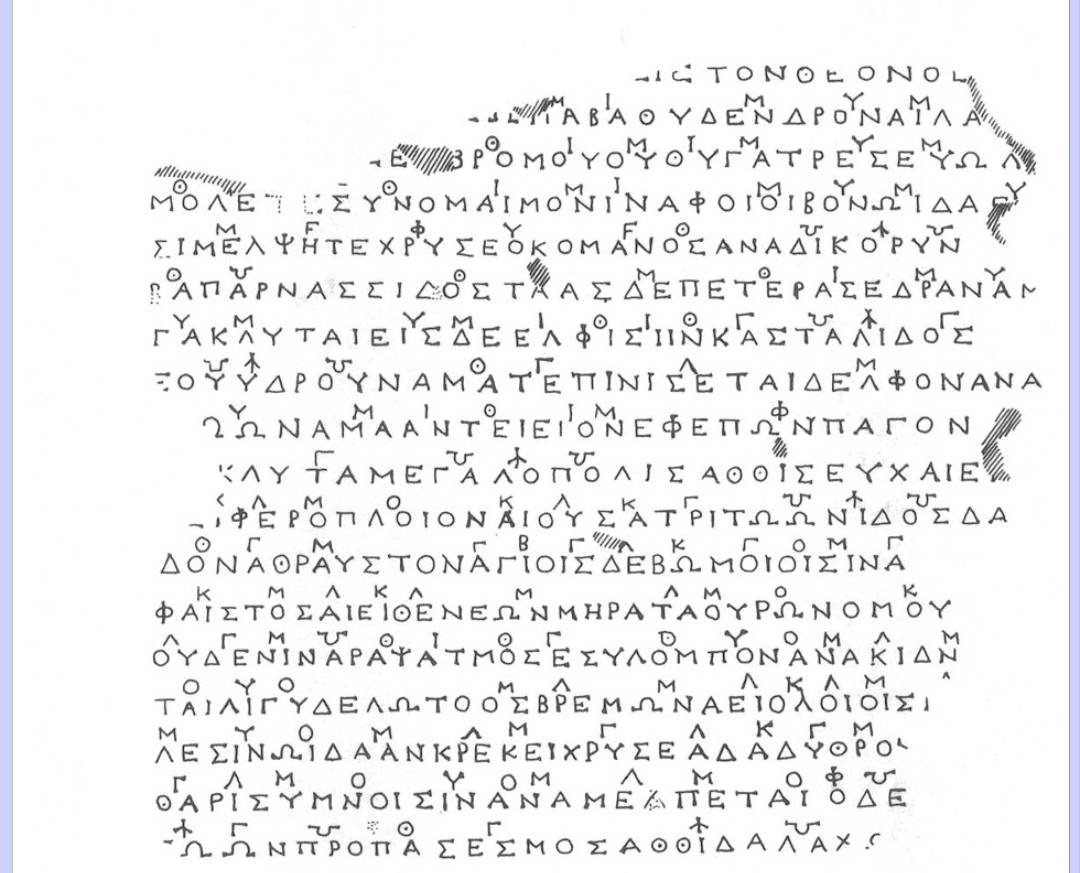
Delphic Hymn to Apollo
Which uses the Dorian tonos, and then the Hypodorian, which looks a little something like this
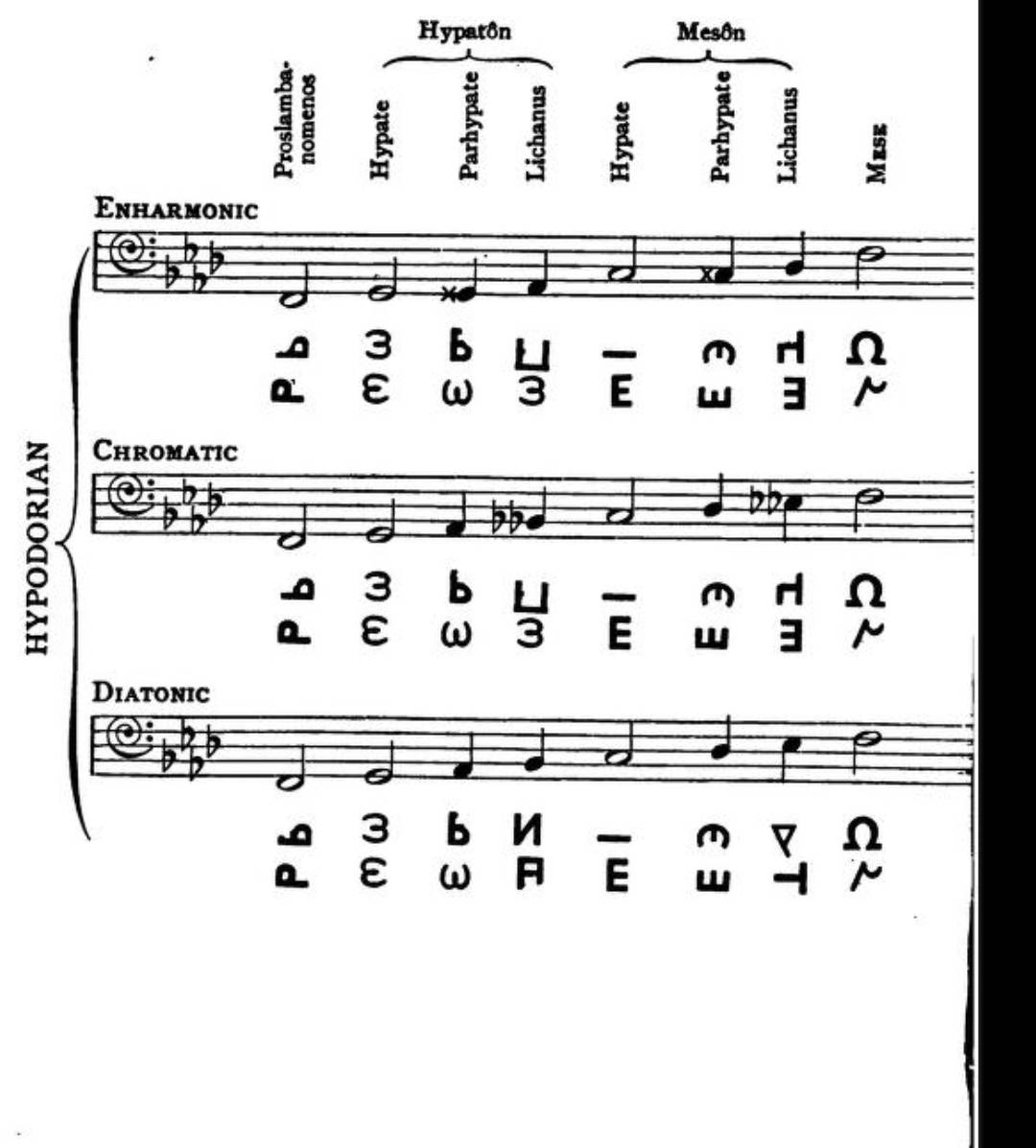
Hypodorian
Seven Modes
The pitch relations of the seven modes are exhibited in the next Table:
| Type | Scale (with tonic in bold) | Step Pattern (F → F) | Step Pattern starting at the tonic |
|---|---|---|---|
| Mixolydian: | F F♯ G♯ A♯ B C♯ D♯ F | F: 1–2–2–1–2–2–2 | D♯: 2–1–2–2–1–2–2 |
| Lydian: | F G A B♭ C D E F | F: 2–2–1–2–2–2–1 | D: 2–1–2–2–1–2–2 |
| Phrygian: | F G A♭ B♭ C D E♭ F | F: 2–1–2–2–2–1–2 | C: 2–1–2–2–1–2–2 |
| Dorian: | F G♭ A♭ B♭ C D♭ E♭ F | F: 1–2–2–2–1–2–2 | B♭: 2–1–2–2–1–2–2 |
| HypoLydian: | F G A B C D E F | F: 2–2–2–1–2–2–1 | A: 2–1–2–2–1–2–2 |
| HypoPhrygian: | F G A B♭ C D E♭ F | F: 2–2–1–2–2–1–2 | G: 2–1–2–2–1–2–2 |
| HypoDorian: | F G A♭ B♭ C D♭ E♭ F | F: 2–1–2–2–1–2–2 | F: 2–1–2–2–1–2–2 |
Vocabulary
Core Musical Concepts
μουσική (mousikē) – “The art of the Muses”; in antiquity, a unified discipline including poetry, melody, rhythm, and dance (Plato, Republic 376e; Laws 653a).ἁρμονία (harmonía) – “Joining, fitting together”; denotes scale system, mode, or tuning structure (Plato, Republic 398e; Aristoxenus, Harm. Elem. I).
ἁρμονίαι (harmoníai) – Plural, the different modal types: Dorian, Phrygian, Lydian, Mixolydian (Aristotle, Pol. 1342a).
ἁρμονικόν (harmonikón) – Theoretical discipline treating intervals and tuning (Aristoxenus, Harm. Elem. I.1).
γένος (genos) – “Genus”; one of the three classes of tetrachordal division: diatonic, chromatic, enharmonic (Aristoxenus, Harm. Elem. I.22).
διατονικόν (diatonikon) – Genus with tone–tone–semitone divisions.
χρωματικόν (chromatikon) – Genus with minor-third + two semitone (or lesser) intervals.
ἐναρμόνιον (enharmónion) – Genus with ditone + two dieses (microtones).
τόνος (tonos) – “Tension,” also “pitch level” or “mode” (Aristoxenus, Harm. Elem. I.13).
ἡμιτόνιον (hemitónion) – Semitone.
δίτονος (ditonos) – Major third (two whole tones).
ἡμιόλιον (hemiolion) – Ratio 3 : 2, the perfect fifth (Pythagoreans).
διαπέντε (diapente) – The fifth.
διατέσσαρα (diatessara) – The fourth.
διάτονον σύστημα (diatonon systēma) – Diatonic scale system.
σύστημα τέλειον μέγα (systēma teleion mega) – “Greater Perfect System,” the complete two-octave framework of Greek scale (Aristoxenus II.35).
σύστημα τέλειον ἐλάσσον (systēma teleion elasson) – “Lesser Perfect System,” the single octave system.
τετράχορδον (tetrachordon) – “Four-string group” spanning a perfect fourth.
συνδεδεμένον / διῃρημένον τετράχορδον – Conjunct / disjunct tetrachord (sharing or separating a note).
ἑπτάχορδον (heptachordon) – Seven-string system.
ὀκτάχορδον (oktachordon) – Eight-string lyre, later extension to full octave.
μεσὴ (mesē) – “Middle” note; central tone of the system, reference pitch (Aristoxenus II.35).
νῆτη (nētē) – “Highest” string.
ὑπάτη (hypátē) – “Lowest” string.
παρανήτη (paranētē), παρυπάτη (parypátē) – Strings adjacent to nētē / hypátē.
λύρα (lyra) – General word for lyre, plucked with fingers
κιθάρα (kithara) – Professional concert lyre, plucked or strummed (Plato, Republic 399d).
πλήκτρον (plēktron) – Plectrum, strumming implement.
χορδή (chordē) – String; also “interval.”
χορδίζω (chordizō) – “To tune” a string instrument.
ἁρμόζω (harmozō) – “To fit, attune”; basis of harmonia.
κατάληψις / σύλληψις (synlēmpsis) – Grammatical “taking together,” also musical combination of sounds.
pitch and accents:
ὀξεῖα (oxeîa) – “Sharp, acute accent”; raises pitch on accented syllable (Herodian, Περὶ καθολικῆς προσῳδίας).
βαρεῖα (bareîa) – “Heavy, grave accent”; indicates normal or slightly lower pitch.
περισπωμένη (perispōménē) – “Circumflex”; pitch rises then falls within the same syllable.
προσῳδία (prosōdía) – “Accent, songlike inflection,” origin of “prosody”; literally “a song added to.”
τονική προσῳδία (tonikē prosōdía) – “Pitch accent” (ancient accent system).
μακρόν (makrón) – Long vowel or long syllable.
βραχύ (brachý) – Short vowel or syllable.
δίφθογγος (diphthongos) – “Double sound”; combination of two vowels forming one syllable.
διαίρεσις (diaíresis) – “Separation”; pronunciation of two vowels distinctly (diaeresis).
συναίρεσις / συνίζησις (synairesis / synízēsis) – “Combination”; fusion of two vowels into one syllable.
ὑπογεγραμμένη (hypogegramménē) – “Iota subscript”; silent iota under long vowel (ᾳ, ῃ, ῳ).
ὑπερβολή (hyperbolē) – “Excess”; high pitch beyond norm (used metaphorically by Aristoxenus).
παροξύτονον / προπαροξύτονον / περισπώμενον – Words accented acute on last / penult / circumflex on penult.